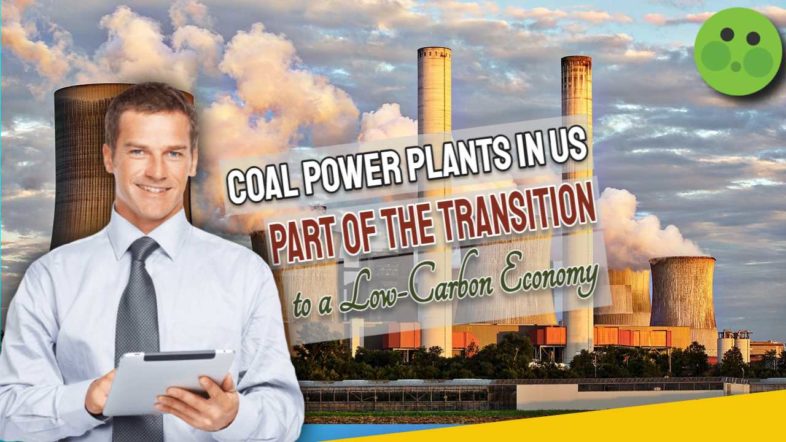The following article outlines a suggested pragmatic strategy for Coal Power Plants in US showing the possible role of these stations in the Biden Administration to Fight Climate Change in the energy sector, with immediate action possible.
There is no need for any Coal Power Plant operators or employees in the US to fear imminent closure of coal power plants in US, instead (by using wood pellet fuel augmentation) they can be part of the transition to a low-carbon economy.
Existing power plants can be part of the transition to a low-carbon economy
By William Strauss | February 04, 2021
SOURCE: FUTUREMETRICS
Prior to the Trump administration, the U.S. had promulgated the Clean Power Plan. The CCP would have required states to achieve lower carbon emission goals in the power generation sector by 2030, contributing to U.S. commitments in the Paris Agreement. In aggregate, the U.S. would have reduced greenhouse gas (GHG) emissions produced by electricity generation by about 32% from 2005 levels by 2030.
FutureMetrics research and analysis, discussed in several white papers since 2015, showed that a part of a strategy for reaching those goals should be support for substituting sustainably produced wood pellets for coal in existing coal power plants in US. This is not a novel idea. The U.S. is the world’s largest producer and exporter of sustainably produced wood pellets that are used in power plants in many nations as part of their GHG reduction strategies. Global trade in pellets that are replacing coal for power generation will be about 24 million metric tons in 2020. Under the CPP, the U.S. would have begun to use domestically produced pellets for meeting U.S. GHG reduction targets.
The Clean Power Plan was scrapped by the Trump administration.
The incoming Biden administration has already demonstrated its commitment to reenergizing the U.S.’s commitment to fighting climate change and reducing carbon emissions. This reenergized attention to climate change will put a focus on how energy is produced and used for transportation, heat and power generation.

Not even considering the environmental benefits of a policy for replacing coal power plants in US with pellets in power plants, because of the job supporting characteristics of the strategy, was erroneous. Even U.S. policymakers who have supported Trump’s environmental policies should support a strategy for substituting sustainably sourced pellets for coal power plants in US.
Climate Change Needs Attention Now
All policymakers should be motivated by the increasing costs of the consequences of a rapidly warming planet. Figure 1 (above) should be a call to action for everyone, regardless of political affiliation. It is produced by the actuaries that advise insurance companies about how to price risk. The trajectory in the chart is not conducive to the cost of doing business.
To get from where we are today to future goals for lower carbon dioxide (CO2) emissions and control over anthropogenic global warming, a portfolio of complementary solutions will be required.
Evolution to Zero Carbon Emissions
As is the case in many countries already, the Biden administration should embrace a portfolio of solutions that optimize the tactics for an effective path to GHG reduction goals for the future. A pragmatic policy for lowering the CO2 intensity of the power generation sector with a transition to renewable energy needs to be tempered with the need to maintain reliability and stability in the delivery of electricity.
Moving to increased renewable generation is more complicated than simply building lots of wind turbines and solar farms. That is often the offered solution, with a reference to solving the intermittency and variability of wind and solar with battery or hydrogen storage. The future for power generation relying heavily on electricity generated from wind turbines and solar farms is a worthy goal that should define the destination. But deploying more wind turbines and solar farms will require massive energy storage at a scale that is orders of magnitude from where we are today.
Grid level energy storage sufficient to support the reliable supply of electricity in a decarbonized power sector without on-demand, so-called “thermal” generation is probably a decade or more away. That is not to say that the goal of a power grid mostly based on the energy in the wind and sun is not a worthy one—it is. But the transition to that goal will take a long time and require continued improvements in storage technology and density.
In the meantime, one component of a strategy that maintains grid reliability during this long transition to a 100% carbon-free generation portfolio is to do what is already being done in many nations: use sustainably produced fuel produced from renewable biomass to replace coal in utility power boilers. Trees and other potential sources of biomass are nature’s natural solar battery.
Using sustainable, upgraded solid fuel made from biomass is not a novel idea. The strategy is proven as effective and economical and is deployable now with no need to invest in new generation infrastructure or wait for improvements in energy storage efficiency and density.
Existing Coal Power Part of Transition
Globally, greater than 43.7 million megawatt-hours (MWh) of baseload electricity will be produced by wood pellets in 2020. Every metric ton of coal that is replaced by wood pellets lowers net CO2 emissions by about 85% in most locations, and each metric ton of pellet fuel contains about 4.8 MWh of renewable energy.
When—and not if—the U.S. creates a policy that will support this well-proven strategy, there are many coal power plants in US. that could benefit either from cofiring, or, in selected locations, conversion to 100% renewable, carbohydrate-based fuel instead of hydrocarbon-based fuels mined from the earth. This existing fleet could continue to supply on-demand power to balance the grid as wind and solar generation increases. The carbon intensity of the power would be proportionally lowered as the ratio of pellets to coal is increased. This on-demand, reduced carbon intensity generation can contribute to goals for lower CO2 per MWh of electricity while transitioning to the day when solar, wind and grid-level energy storage are sufficient.

Figure 2 (see the pdf here) chart shows the age distribution of all 529 of the U.S. coal power generation units. There are 41 units that are less than 15 years old, and at least three decades of life left in these newer, high-efficiency units representing about 22,000 MW of capacity.
If some of these units are used rather than closed, they can contribute to lowering carbon emissions in the power sector and avoid the real ratepayer costs of stranded assets.
Coal Power Plants in US – Conclusion
If U.S. policy supports the above strategy, there is no shortage of winners. The following points summarize the many benefits:
- The environmental benefits are immediate and quantifiable. Lowering carbon emissions by 10% requires a pellet-to-coal ratio of about 11.24% pellets and 88.76% (this will vary slightly based on different energy contents of coal and pellets). Almost no investment is required for modifications to the power station. For the lignite-burning plants, it can happen
overnight. - Power generation assets that are fueled with coal gain a significant new value as the only pathway that allows the use of pellet fuel. At a cofiring rate that results in a 10% CO2 reduction, the increase in the cost of generation is estimated to be less than one
cent per kilowatt-hour. - Coal producers have a secure market for their product with a known ramp-down in demand over the next decade or longer. Cofiring is not possible with natural gas turbines.
- Pellet producers have a new and gradually increasing market, also with known demand. Many underutilized, industrial working forests, such as those in West Virginia, are not in optimal locations for the existing pellet export market. U.S. pellet manufacturers have already invested more than $1.7 billion in facilities in states like Mississippi, Alabama, Arkansas, Texas, Georgia, North Carolina and South Carolina for the export markets. Many thousands of jobs are associated with this existing capacity. New capacity for a U.S. market would replicate that history.
- U.S. workers benefit from a carbon mitigation solution that not only maintains jobs but increases the demand for labor. Natural gas plants require very little labor in the fuel supply chain relative to coal and pellets. Wind and solar power plants require no labor for the fuel supply. The incoming Biden administration is expected to engage in sensible carbon reduction strategic planning. It should take a serious look at the ideas in this article as they formulate their version of the Clean Power Plan.
Author: William Strauss
President, FutureMetrics Inc.
William.strass@futuremetrics.com
www.futuremetrics.com
Best Low Carbon Farming Practices & Techniques
Farmers are turning to low carbon techniques like no-till farming and precision agriculture to combat climate change. These practices not only reduce emissions but also improve soil health and farm profitability, offering a resilient future for agriculture as weather patterns grow increasingly unpredictable…
Which Gas is Produced from Landfill Waste: The Gas that Trash Produces…
Discover which gas is produced from landfill waste and understand its environmental impact and potential energy use. Explore landfill gas management.
Biogas Innovators Take Centre Stage: The World Biogas Awards 2024
Since 2011, a prestigious ceremony has been quietly moving the world on a path back to sustainability – not with flashy gadgets or social media trends, but with something far more fundamental: biogas innovation. The annual AD and Biogas Industry Awards, held in Birmingham, UK, celebrate the brilliance behind this renewable energy source, recognizing the […]
Climate Change Management Strategies: A Comprehensive Guide
Climate change poses significant challenges to the planet and its inhabitants. To address these challenges, it is essential to adopt comprehensive climate change management strategies. These strategies aim to mitigate greenhouse gas emissions, adapt to the impacts of climate change, and build resilience to future climate-related risks. Purpose of Climate Change Management Strategies The purpose […]








